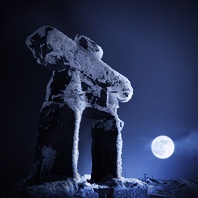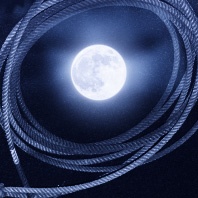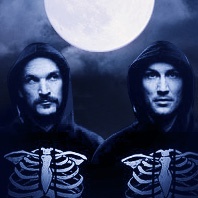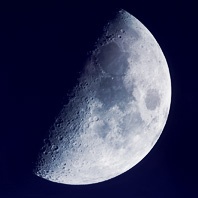Sir Charles Spencer Chaplin (1889–1977) is considered one of the first movie stars ever and made film history with his acting and his works. He is also one of the few artists who managed the transition from silent films to sound films.
Because of using archetypal imagery and symbols in his films, it is natural that the moon could also play a part somewhere. We found four references:
Read more
We have already searched and found the word »full moon« in the Bible, but only in two places in the Old Testament (Psalm 81:3–4 and Proverb 7:18–20). This is surprising, because the Last Supper of Jesus and his disciples must have taken place during the full moon, and hence, should have been mentioned in the New Testament.
We have extended our research and have looked for the word »moon« in the Bible. Here too, most passages can be found in the Prophetic books and Psalms of the Old Testament. However, there are also two places in the New Testament in the Gospel of Luke and Mark.
Read more
We had already told you about the paintings of romanticism by German painters Caspar David Friedrich (1774–1840) and Philipp Otto Runge (1777–1810). And also the English painter William Turner (1775–1851) had the moonlight in his mind. Here we are looking at the next generation and find the Dutch-Belgian artist Petrus van Schendel (1806–1870), whose speciality were the nightly moonlight sceneries. What distinguished him from his predecessors and colleagues, was that it were precisely those depictions of nightlight, which brought him fame and not an insignificant financial success (which was not a given for many painters).
Read more
In many languages, inside the word for the weekday »Monday« you find the word »moon«, sometimes slightly modified but mostly easily recognised. This does not appear to be a coincidence. But why? Surely, the Moon cannot only be seen on Mondays and no other good reasons comes to mind quickly why a specific day of the weekly cycle should be connected to the Moon.
Read more
Paul Klee (1879–1940) was a German painter and graphic artist, one of the biggest names of the Classic Modern Era, being the time at the beginning and first half of the 20th century, which was expressed in so many different styles and is nowadays regarded as avant-garde of that time. Paul Klee created cubistic, expressionistic and surrealistic paintings. The names of his friends read like the »who’s who« in the art scene: August Macke, Wassily Kandinsky, Franz Marc, Walter Gropius, Robert Delaunay, Lyonel Feininger, Alexej von Jawlensky, Pablo Picasso …
Read more
When taking a look at the Inuit [*] in the far north, you will find astonishing myths about the full moon. The Inuit live along the Arctic Ocean from the north east of Russia to Greenland and Canada, where coldness reigns. The culture is imprinted by an archaic consciousness, life is interwoven with legends that were never written down, due to harsh living conditions, but only passed down by word of mouth.
Read more
There are movies that live on Mount Olympus. The movie “It’s a wonderful life” by Frank Capra from 1946, belongs to them. However, at the time of the release, shortly before Christmas of the aforementioned year, this had not been the case yet. Commercially, this movie was a flop and did not turn into a cult movie until decades later. Today, the story about George Bailey (played by James Stewart), who does many good deeds in a small American town, quarrels with his destiny on Christmas Eve and eventually, through meeting an unconventional angel, learns to recognise the value of life, is considered to be one of the best movies in motion picture history.
Read more
We have already reported about the subject “Sleeping at the full moon” with the insight that the phenomenon of a restless or bad sleep around the full moon apparently exists for many people, however, we are groping in the dark if looking at the background. Generally, skeptics claim that insufficient sleep is connected to the fact that the people concerned are more or less aware of it being a full moon and therefore eventuate a self-fulfilled prophecy. Those affected, counter that they often find out afterwards whether it was the full moon or it had not occurred to them yet to make this connection at all.
Read more
There is a wide spectrum of views and opinions about how the moon may influence human life and it is in the very nature of things, that these opinions lead to discussions. During the course of the years, we got acquainted with many different viewpoints and are trying to give room to these diversities on these pages.
Let’s imagine two people for example, a sceptic, who analyses sensibly and critically, and a mystic who allows his actions to be guided by faith and dedication. Let’s have both people answer the question, whether principally, full moon has an effect on human beings.
Read more
There are quite a few full moon songs, with Frank Sinatra’s »full moon and empty arms« leading the way, from 1945, which was inspired by Rachmaninoff’s piano concert No. 2 (you can hear this in the comparison). A newer example would be the »full moon song« by Peter Bradley Adams from 2011, or the song »full moon« by the British music duo The Black Ghosts (Theo Keating and Simon William Lord) from 2006, which achieved a high level of publicity in 2008 as the soundtrack of the movie »Twilight«. The song may have probably not been that successful, if the music supervisor Alexandra Patsavas hadn’t chosen it for the soundtrack.
Read more
No, this is not about another sequel of the science fiction movie or whether Arnold Schwarzengger is planning a trip to the moon … It is more about an astronomical term, where »terminator« describes the day-night border of a celestial body. This is the visible border between the illuminated side and the dark side of the object, being the border between day and night on the celestial body. The word »terminator« derives from Latin »terminare« = conclude, restrict.
Read more










